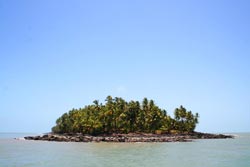Characterizing the world’s islands for biodiversity research

Tropical island of volcanic origin: Îles de Salut, off the coast of French-Guayana.<br>Photo: Patrick Weigelt, Goettingen University <br>
A team of researchers from the University of Göttingen in Germany and Yale University (USA) has presented the most comprehensive description and characterization so far of bioclimatic and physical characteristics of the world’s islands.
Islands make up only five percent of the land surface of the Earth, but they are home to a disproportionately high number of plant and animal species and provide ecosystem functions and services to more than 500 million people.
However, a quantitative description of the ecological conditions on islands had been lacking so far. The study published this week in the prestigious scientific journal Proceedings of the National Academy of Sciences now closes this gap.
The researchers investigated almost 18,000 marine islands with areas greater than one square kilometer. They also compiled ecologically important climate data and precise information about physical factors such as area, distance to the next continent and the proportion of landmass in the surroundings of each island. “The data that have been available so far have been woefully incomplete, imprecise – and often just wrong,” Patrick Weigelt from the University of Göttingen, first author of the study, explained.
The researchers employed modern statistical approaches to describe, classify and map the islands based on differences in their environments. This allows the identification of islands with similar environmental settings and will facilitate further island biogeographical studies and biodiversity conservation.
“These new results provide a novel perspective on thousands of our planet’s islands,” said Prof. Dr. Holger Kreft from the University of Göttingen, leader of the study. For instance, 65 percent of all islands are located in the tropics, but compared to mainlands, island climates are on average cooler and more humid. “An interesting finding of our study is that there are many more islands with a temperate rainforest climate, one of the rarest ecosystems on Earth, than expected by chance,” said Prof. Kreft.
The new insights may play an important role in understanding the evolution of biological diversity on islands. “Islands are microcosms where the evolution of biological diversity can be studied. Now, for the first time, we have a standardized global data set as a starting point for further global studies on island biodiversity,” Kreft added.
Original publication:
Patrick Weigelt et al. Bioclimatic and physical characterization of the world’s islands. Proceedings of the National Academy of Sciences of the USA. August 2013. www.pnas.org/cgi/doi/10.1073/pnas.1306309110
Contact:
Prof. Dr. Holger Kreft
Georg-August-Universität Göttingen
Free Floater Research Group “Biodiversity, Macroecology and Conservation Biogeography“
Büsgenweg 1, 37077 Göttingen, Germany, Phone +49 (0)551 39-10727
Email: hkreft@uni-goettingen.de
Weitere Informationen:
http://www.uni-goettingen.de/de/3240.html?cid=4547 more photos
http://www.uni-goettingen.de/biodiversity research group
Media Contact
More Information:
http://www.uni-goettingen.de/All latest news from the category: Life Sciences and Chemistry
Articles and reports from the Life Sciences and chemistry area deal with applied and basic research into modern biology, chemistry and human medicine.
Valuable information can be found on a range of life sciences fields including bacteriology, biochemistry, bionics, bioinformatics, biophysics, biotechnology, genetics, geobotany, human biology, marine biology, microbiology, molecular biology, cellular biology, zoology, bioinorganic chemistry, microchemistry and environmental chemistry.
Newest articles

Superradiant atoms could push the boundaries of how precisely time can be measured
Superradiant atoms can help us measure time more precisely than ever. In a new study, researchers from the University of Copenhagen present a new method for measuring the time interval,…

Ion thermoelectric conversion devices for near room temperature
The electrode sheet of the thermoelectric device consists of ionic hydrogel, which is sandwiched between the electrodes to form, and the Prussian blue on the electrode undergoes a redox reaction…

Zap Energy achieves 37-million-degree temperatures in a compact device
New publication reports record electron temperatures for a small-scale, sheared-flow-stabilized Z-pinch fusion device. In the nine decades since humans first produced fusion reactions, only a few fusion technologies have demonstrated…





















